Easy Does It #8: Double Happiness
🧧 A poignant piece of card magic with a lucky red envelope, perfect for a wedding.
Difficulty: ⭐⭐ (Easy)
Duration: ⏱️⏱️ (7-10 minutes)
Setup Time: 🎯 (Minimal)
Welcome to another edition of Easy Does It, a regular Ruseletter column about simple (and sometimes self-working) magic tricks that you can learn to impress your friends and family. Today, we’re going to explore a deeply romantic card trick called “Double Happiness” and discuss how a practical understanding of Hay’s Paradox can help you become a better performer. 🥰
This free edition of Marty’s Magic Ruseletter is made possible by the generosity of paid subscribers. Thank you! If you’d like to become a paid subscriber to the Ruseletter and support my writing, you can do so for $5 per month (or $50 annually).
Regular readers of the Ruseletter will know that recently I’ve been on a bit of a mission to share romantic-themed magic tricks suitable for weddings, engagement parties, or wedding anniversary celebrations. (See Easy Does It #4: Sixpence Ceremony, Easy Does It #7: Simplex Soulmates, and Packet Trick Paradise #12: Red Thread of Fate for three good examples of this type of magic.) I’m not entirely sure why I enjoy these tricks so much; perhaps I’m a hopeless romantic! Anyway, “Double Happiness” is another trick of the same vein; it aims to strengthen the bond between two people by helping them discover what makes their relationship unique and special.
The idea behind this particular trick stemmed from the observation that the Chinese decorative character for double happiness, shuāngxǐ (囍), looks very much like the two red Eights in a deck of playing cards (see graphic below for a typical example of the symbol).
There are many ways to render it because it is not a standard Chinese character. Shuāngxǐ, pronounced “shwong-shee”, is, in fact, an ornamental ligature made of two side-by-side copies of the Chinese character for joy (喜). It frequently appears on traditional decorative items related to marriage, including “hongbao”—lucky red envelopes usually containing cash—given to the bride and groom on their wedding day. 🧧
The colour red symbolises good luck and prosperity and is thought to ward off evil spirits. The act of giving and receiving a hongbao is also a popular way to share joy and extend good wishes during the Lunar New Year and on people’s birthdays in China and other parts of East and Southeast Asia.
There are many different artistic interpretations of the symbol. Below, I’ve collected eight examples to give you an idea of how the symbol is interpreted. (Some resemble the two red Eights in a deck of playing cards more than others.)
To perform “Double Happiness”, you’ll need a deck of playing cards, a red envelope, and a specially printed “numerological chart” (you can make one of these by hand with a few pens and a piece of paper). You can purchase authentic Chinese “hongbao” from wedding supply shops to use in this routine. (You can also buy them on sites like Amazon and Etsy, but try to buy your magic supplies like this from a local, family-run business, if possible.)
Because it resembles the two red Eights and is often depicted in red, the double happiness symbol can serve as an “ambiguous open prediction” of the Eight of Hearts and Eight of Diamonds. When a spectator looks at it, it doesn’t seem to make any sense or appears to be there for decorative purposes only. Therefore, it can be openly displayed before any cards are chosen. It is only later, when the magician clarifies the situation, that the audience can correctly interpret the markings as a prediction (see example pictured below).
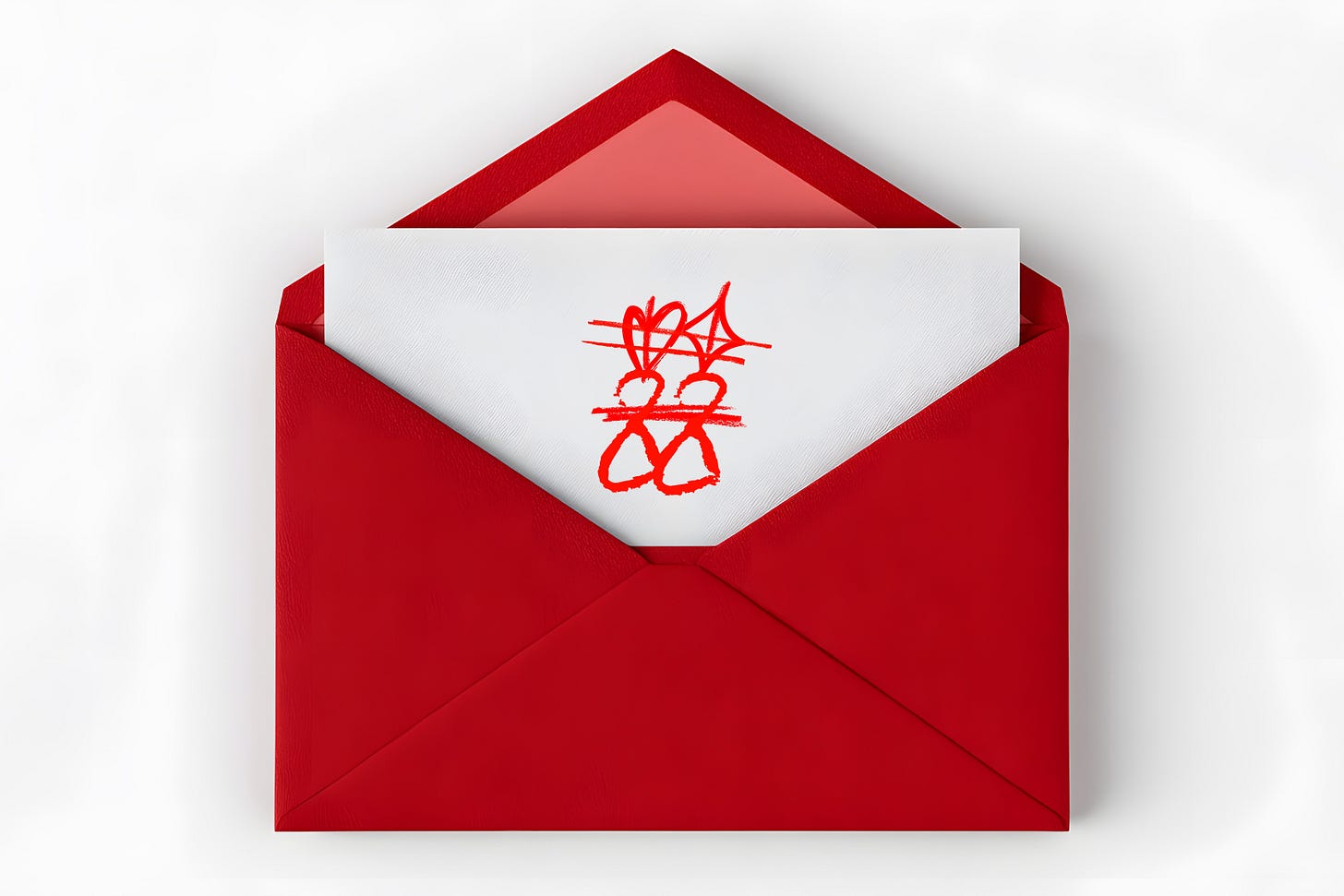
To maximise its impact as an ambiguous open prediction, it’s advisable to print or draw a customised version of the double happiness symbol that includes a small Heart and Diamond pip within the character itself (see below for a representative mock-up of an envelope with this type of symbol printed on it).
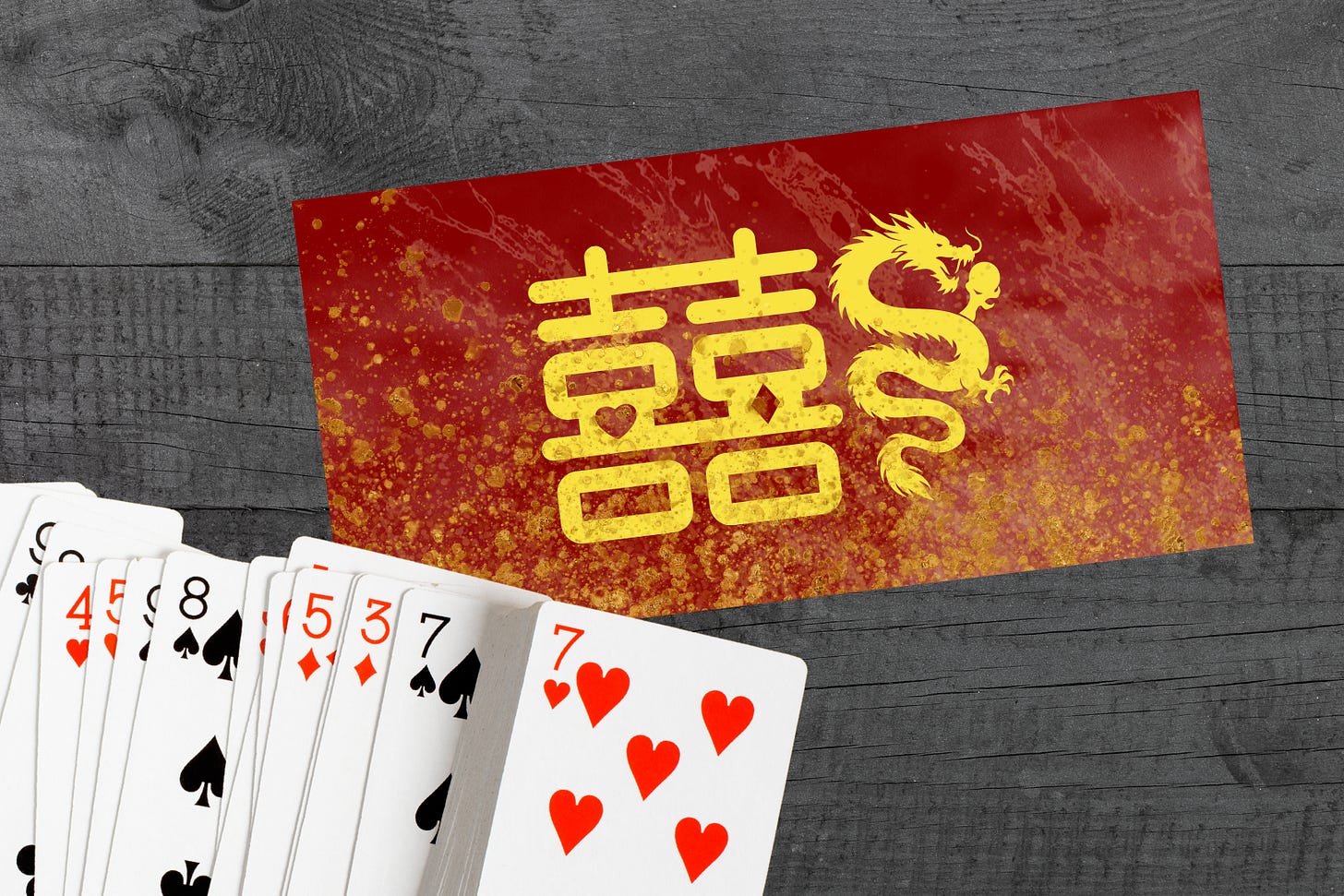
Here’s what happens in “Double Happiness”:
The bride and groom thoroughly shuffle a deck of cards. Using a numerology chart and some personal choices about their relationship, they generate a unique “Planetary Colour Number”. This number guides a process where they deal and freely eliminate cards until only two remain. Remarkably, these are the Eight of Hearts and Eight of Diamonds—what a magical coincidence!
The magician explains that these two cards symbolise their matrimonial union, echoing the Chinese “double happiness” symbol (囍) printed (or drawn) on a lucky red “hongbao” envelope. The happy couple receive these cards in the decorative envelope as a treasured keepsake.
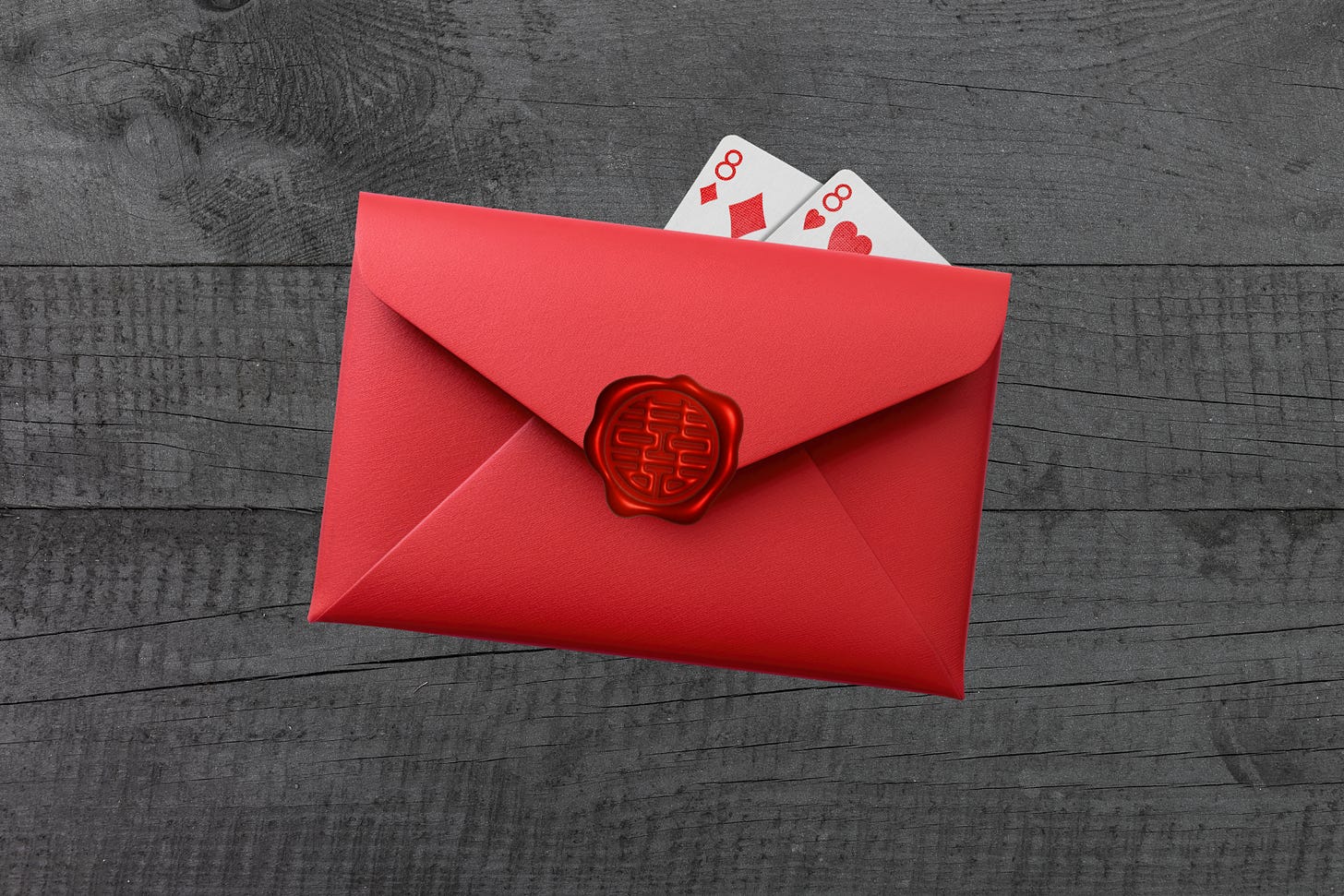
Hay’s Paradox
In his book The Amateur Magician’s Handbook, author Henry Hay (1910-1985), whose real name was June Barrows Mussey, dedicates an entire chapter to what he calls the “Paradox of Practice”. His theory concerns the difficulty of a magic trick, or, in other words, whether it is easy or hard to perform. For this reason, the chapter has the puzzling title “Hard Easy Tricks and Easy Hard Tricks”.
If you start off with a few self-working tricks that you can plod through undetected, you may puzzle people, but you won’t entertain them. Worse, you won’t have entertained yourself. Easy come, easy go. Familiarity breeds contempt.1
What are Hard Easy Tricks? (Sleight of Hand)
Hay’s main argument is that most magicians should begin by learning more technically demanding tricks because the time required to learn a simple sleight of hand sequence, or what Hay sometimes calls a “manual artifice”, forces you to develop the necessary acting and showmanship skills to effectively “sell” the magical effect to an audience. These are his so-called “hard easy tricks”.
Such tricks are “hard” because the sleights involved require substantial practice to learn. Nonetheless, this very difficulty makes them “easy” in the long run because the extensive practice needed to master the mechanics naturally forces the performer to internalise the timing, acting, and showmanship necessary for a good presentation. You can’t perform them half-practised without risking embarrassment, so you do the work. Here’s how Henry Hay describes it:
In short, you can learn to do a moderately difficult trick well more easily than you can a perfectly easy trick. On a sleight-of-hand trick you can’t skimp; on an easy trick the temptation is almost irresistible. You won’t dare to show a feat of skill that is only half practiced—and this is one of the basic axioms in all conjuring.2
What are Easy Hard Tricks? (Self-Working)
Conversely, with so-called “self-working” miracles (tricks that can be learnt in mere minutes), the temptation to perform them without putting in the necessary time and effort is, as Hay points out, almost irresistible! This makes them “easy hard tricks” in Henry’s eyes because, while they are easy on a technical footing, a lot of hard work is required to make them entertaining.
They’re “easy” because the methods demand little in the way of manual skill or dexterity. This makes them quick to learn, but “hard” to present convincingly; the lack of mandatory mechanical practice creates a strong tendency, especially in amateur magicians, to neglect the crucial, and genuinely difficult, task of developing the presentation, timing, and showmanship needed to transform a mere puzzle into an engaging piece of magic.
What Does This All Mean?
Put simply, Henry Hay’s “Paradox of Practice” argues that, especially for beginners, tricks involving difficult sleight of hand (“hard easy tricks”) are paradoxically easier to learn and perform competently in an entertaining manner than mechanically simple, self-working tricks (“easy hard tricks”).
In essence, the time and effort demanded by difficult sleight-of-hand aids the development of performance skills. In contrast, the lack of effort required by simple, self-working magic makes developing a strong performance a separate, and often completely neglected, challenge.
So, to address Hay’s Paradox, there are two obvious solutions:
Perform more technically demanding magic or
Rise to the challenge and develop a compelling presentation for easy or self-working tricks
“Double Happiness”, which relies on the Count-Back Force and equivoque, is mechanically simple and largely self-working. Therefore, according to Henry Hay’s definition, it’s a classic example of an “easy hard trick”. It’s “easy” because the method doesn’t demand difficult sleight of hand. But it’s “hard” because a performer must consciously invest significant time and effort in the presentation, scripting, audience management, and emotional framing to elevate it beyond a puzzling procedure.
“Double Happiness” is exactly the sort of trick Henry Hay warns beginners about in his book. Because the easy method is quickly learnt, it’s very tempting to perform it before you’re ready; before you’ve developed, practised, and rehearsed an engaging presentation. This is the real hard work of “easy hard tricks”!
Learn Double Happiness
To assist you in this endeavour, I’ve dedicated considerable time to developing and writing a comprehensive tutorial for “Double Happiness”. You will still need to devote time and effort to make the trick uniquely yours. However, I hope my write-up will give you a head start and ongoing motivation to turn all your “easy hard tricks” into spectacular showstoppers!
If you have any questions or queries about the routine, please let me know by replying to the email or leaving a comment below. I hope this new trick of mine brings you many hours of Shuāngxǐ! 囍
Yours Magically,
Marty
Henry Hay, The Amateur Magician’s Handbook (Castle Books, 1982), 10.
Hay, The Amateur Magician’s Handbook, 11.

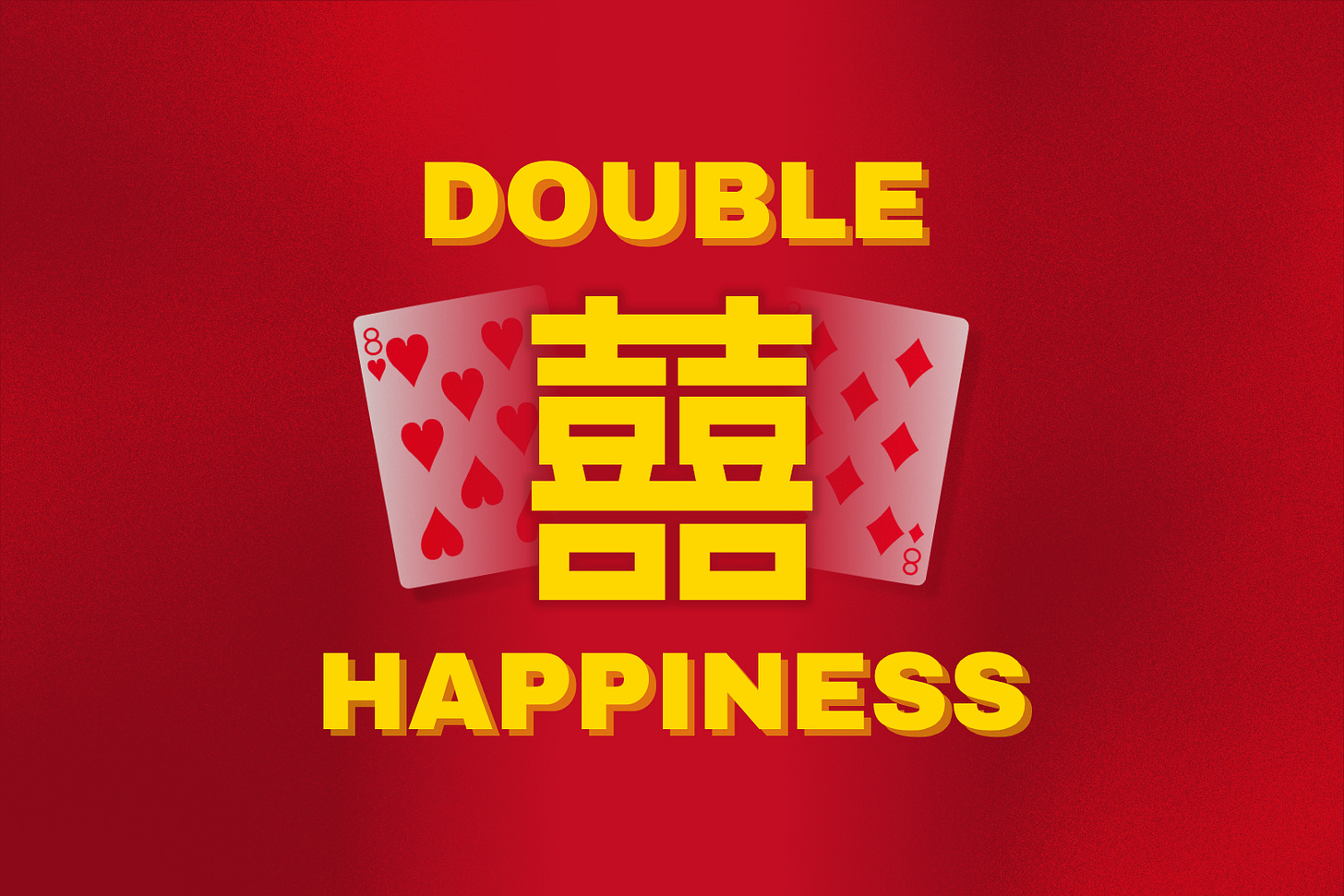
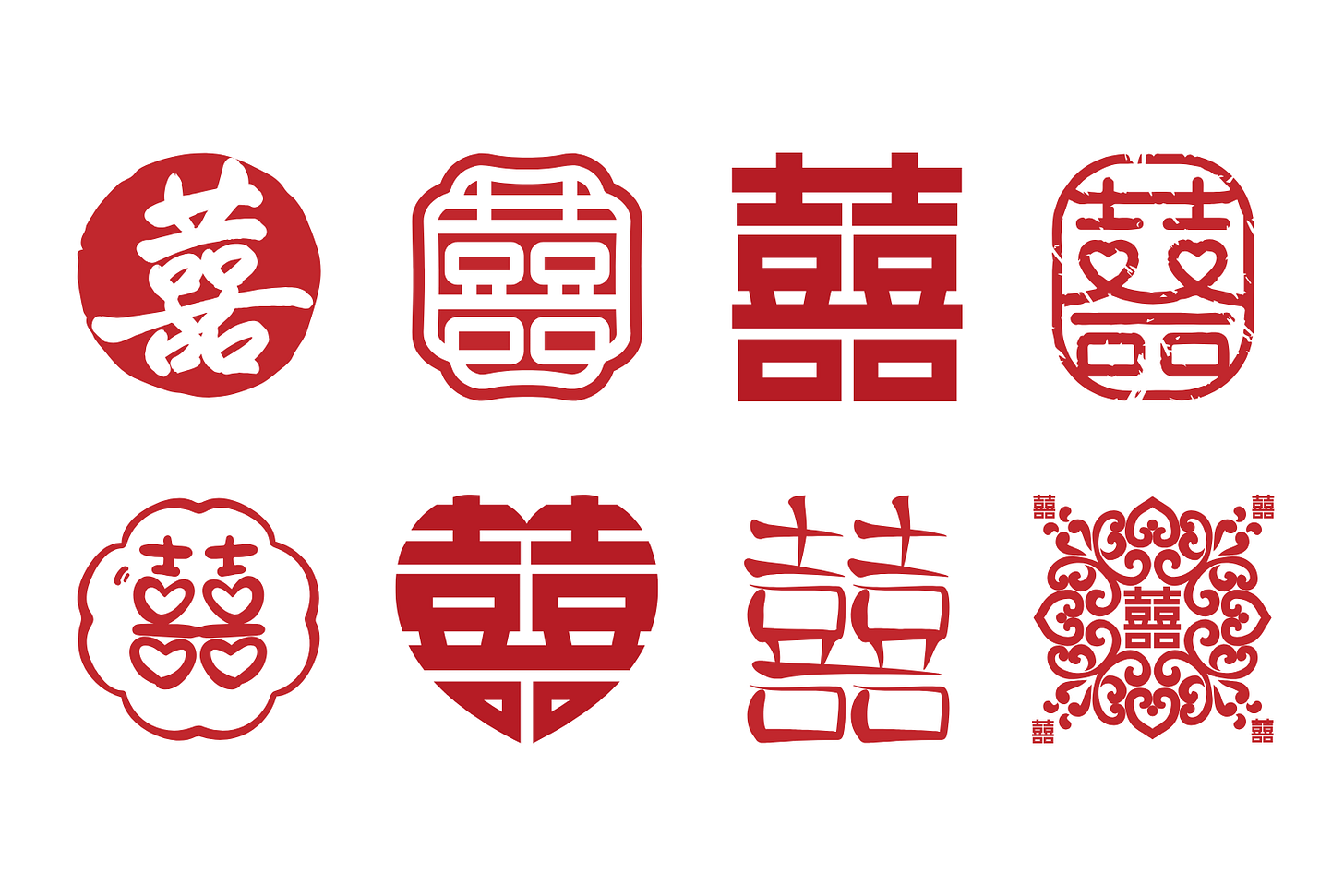
I'd never heard of Hay's Paradox before, but it makes so much sense to me. I often think of tricks I know that require relatively difficult sleights such as a cull or a top change as being my "sure things", whereas there are plenty of self working tricks that I don't feel comfortable doing due to lack of what I consider myself to compelling presentation. Now I'll have to pick up "The Amateur Magician's Handbook"
Love the double happiness artwork.